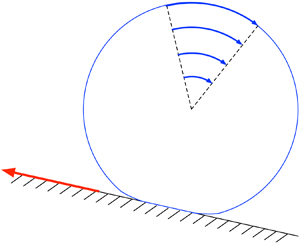Article contents
Rolling of non-wetting droplets down a gently inclined plane
Published online by Cambridge University Press: 28 September 2020
Abstract

We analyse the near-rolling motion of non-wetting droplets down a gently inclined plane. Inspired by the scaling analysis of Mahadevan & Pomeau (Phys. Fluids, vol. 11, 1999, pp. 2449–2453), we focus upon the limit of small Bond numbers, where the drop shape is nearly spherical and the internal flow is approximately a rigid-body rotation except close to the flat spot at the base of the drop. In that region, where the fluid interface appears flat, we obtain an analytical approximation for the flow field. By evaluating the dissipation associated with that flow we obtain a closed-form approximation for the drop speed. This approximation reveals that the missing prefactor in the Mahadevan–Pomeau scaling law is  $(3{\rm \pi} /16)\sqrt {3/2}\approx 0.72$ – in good agreement with experiments. An unexpected feature of the flow field is that it happens to satisfy the no-slip and shear-free conditions simultaneously over both the solid flat spot and the mobile fluid interface in its vicinity. Furthermore, we show that close to the near-circular contact line the velocity field lies primarily in the plane locally normal to the contact line; it is analogous there to the local solution in the comparable problem of a two-dimensional rolling drop. This analogy breaks down near the two points where the contact line propagates parallel to itself, the local flow being there genuinely three dimensional. These observations illuminate a unique ‘peeling’ mechanism by which a rolling droplet avoids the familiar non-integrable stress singularity at a moving contact line.
$(3{\rm \pi} /16)\sqrt {3/2}\approx 0.72$ – in good agreement with experiments. An unexpected feature of the flow field is that it happens to satisfy the no-slip and shear-free conditions simultaneously over both the solid flat spot and the mobile fluid interface in its vicinity. Furthermore, we show that close to the near-circular contact line the velocity field lies primarily in the plane locally normal to the contact line; it is analogous there to the local solution in the comparable problem of a two-dimensional rolling drop. This analogy breaks down near the two points where the contact line propagates parallel to itself, the local flow being there genuinely three dimensional. These observations illuminate a unique ‘peeling’ mechanism by which a rolling droplet avoids the familiar non-integrable stress singularity at a moving contact line.
JFM classification
- Type
- JFM Papers
- Information
- Copyright
- © The Author(s), 2020. Published by Cambridge University Press
References
REFERENCES
- 7
- Cited by



